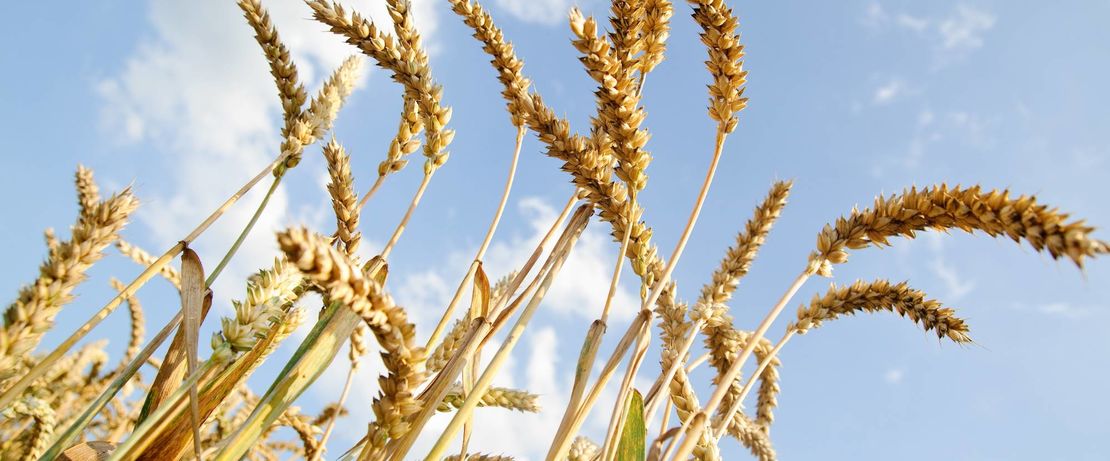
Natural nutrient providers: Bacteria to reduce the use of fertilizers
Evonik is engaged in research into microorganisms that provide cereal crops with atmospheric nitrogen and thus promote their growth.
- Microbial biostimulants from Evonik supply nitrogen to wheat and corn and promote growth
- A greenhouse trial indicates that the use of synthetic fertilizers can be reduced successfully
- Environmentally friendly alternative for farmers
Essen, Germany. Evonik is engaged in research into microorganisms that provide cereal crops with atmospheric nitrogen and thus promote their growth. Plants need nutrients such as nitrogen in order to grow. To meet this essential need, farmers currently use large quantities of synthetic fertilizers. However, these impact the environment and the climate. Evonik is working on an alternative: The new development is a unique combination of bacteria and bio-based additives that has the potential to significantly reduce the use of synthetic nitrogen fertilizers.
“Our new solution can help farmers safeguard crop yields with less fertilizer in the future,” says Jan Wolter, who heads the Farm to Form area at Creavis, Evonik's strategic innovation unit and business incubator. The European Union's goal is a 20 percent reduction in the use of fertilizers by 2030.
Evonik’s new development belongs to the class of microbial biostimulants. These stimulate natural processes in soil and plants, improve nutrient uptake, and promote growth. Like conventional leaf fertilizers, Evonik's biostimulants are sprayed onto the upper side of foliage. From there, they reach the underside, where there are small pores known as stomata. Through these, the nitrogen-fixing bacteria penetrate the leaf, where they can act as biostimulants. Within the leaf, the bacteria are protected from environmental factors such as rain and UV radiation and act as natural nutrient providers. “In extreme weather periods, the protection offered by the inside of the leaf is important for the efficacy of biostimulants,” explains Wolter.
To make sure the bacterial agents reach the right site in the plant, a biodegradable spreader from Evonik's BREAK-THRU® product range is used. In combination with SIPERNAT® silica, this increases the lifetime and storage stability of the microorganisms. “We are benefiting from our expertise in microbiology, agriscience, and chemical formulation because the bacteria's specific ability to provide nitrogen to the plants can only be used efficiently in combination with these Evonik aids,” says Wolter.
An initial greenhouse trial with wheat and corn showed a promising reduction of up to 50 percent in the use of nitrogen fertilizers. Wolter's team is now conducting field trials in various environmental conditions to verify the results obtained in the greenhouse. In addition, the team is working on the optimum formulation of bacteria and additives, in this case spreaders and carriers. Evonik expects to launch the first biostimulant formulations commercially between 2025 and 2027. “Our innovation has the potential to become a stepping stone to the future of agriculture. It could greatly reduce the use of nitrogen fertilizers without reducing crop yields,” says Wolter.
In conventional agriculture, crops mainly obtain the essential nitrogen nutrients from synthetic fertilizers. Worldwide, 113.7 million metric tons of fertilizer were used in 2020/2021. However, production generates more CO2 than product: 1.2 metric tons of CO2 per metric ton of fertilizer. Furthermore, intensive fertilization contaminates the soil and groundwater and generates laughing gas, a greenhouse gas that adversely affects the climate. The European Commission wants to counteract this with its Farm to Fork Strategy and is aiming to greatly reduce the amounts used by 2030: The goal is to reduce agricultural use of mineral fertilizers by 20 percent and pesticides by 50 percent. These goals, together with rising fertilizer prices, are increasing pressure on the agricultural sector to find new and more sustainable ways of producing food.
At the same time, the new EU Fertilising Products Regulation of July 16, 2022, is giving Evonik's R&D tailwind: In this regulation, for the first time, the European Commission provides biostimulants with a uniform legal basis as a new class of crop protection products. That paves the way for EU-wide commercialization. The European Biostimulants Industry Council estimates that the market for biostimulants is growing by between 10 and 12 percent a year.
Background: biostimulants
Plant biostimulants are additives such as microorganisms, algae extracts, and amino acids. Unlike fertilizers, they have an extremely low nutrient content. Biostimulants do not contaminate plants or the environment. They stimulate natural processes in soil and plants and promote growth by improving nutrient uptake and protecting plants against abiotic stress factors such as drought and frost.
Company information
Evonik is one of the world leaders in specialty chemicals. The company is active in more than 100 countries around the world and generated sales of €15 billion and an operating profit (adjusted EBITDA) of €2.38 billion in 2021. Evonik goes far beyond chemistry to create innovative, profitable and sustainable solutions for customers. About 33,000 employees work together for a common purpose: We want to improve life today and tomorrow.
Information about Creavis
Evonik is one of the world leaders in specialty chemicals. The company is active in more than 100 countries around the world and generated sales of €15 billion and an operating profit (adjusted EBITDA) of €2.38 billion in 2021. Evonik goes far beyond chemistry to create innovative, profitable and sustainable solutions for customers. About 33,000 employees work together for a common purpose: We want to improve life today and tomorrow.
Disclaimer
In so far as forecasts or expectations are expressed in this press release or where our statements concern the future, these forecasts, expectations or statements may involve known or unknown risks and uncertainties. Actual results or developments may vary, depending on changes in the operating environment. Neither Evonik Industries AG nor its group companies assume an obligation to update the forecasts, expectations or statements contained in this release.
